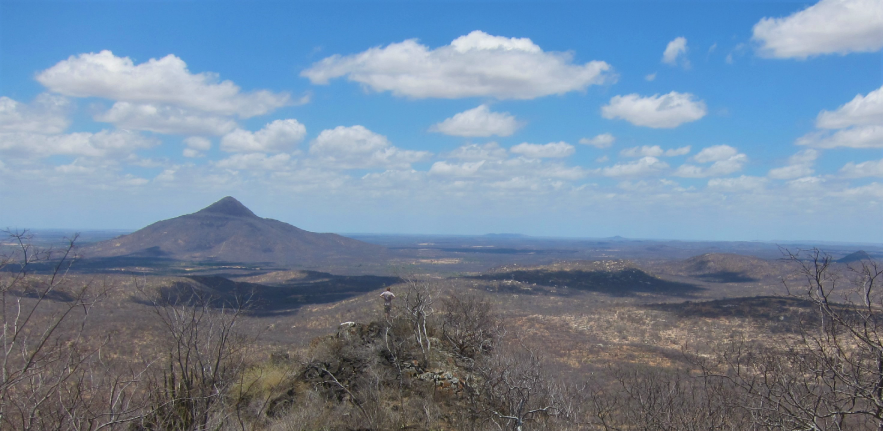
Submitted by Administrator on Thu, 01/10/2020 - 09:39
Brazil’s Borborema Plateau is in the middle of the South American plate - well away from the dynamic tectonic forces of subduction in the Andes Volcanic Belt. Plate theory suggests that passive areas like Borborema should be flat and stable, with little movement of the crust. But the region, which is thousands of kilometres across and a domed shape, has actually risen by up to a kilometre over the last 30 million years.
Recent work led by Marthe Klöcking, who is now at the Australian National University but undertook the research whilst a Cambridge Earth Sciences PhD with Nicky White and John Maclennan, suggests that these extensive topographic features can be caused by thinning of the underlying lithosphere coupled with small positive temperature anomalies in the asthenosphere – leading to further thinning and buoyancy of the lithosphere.
Klöcking and co-authors tracked the movements of Borborema and another, well-known example of basin-and-swell topography in Angola, southwestern Africa, over the last 100 million years. The team reconstructed the changing land surface over time by examining stratigraphic evidence of uplift, including ancient river profiles and emergent marine terraces.
According to Klöcking, "the Borborema and Angolan domes are what we’d describe as dynamic topography, which is any change at the Earth’s surface caused by density and buoyancy differences in the mantle. This is not your usual topography associated with mountain building, where a thick crust supports the development of high elevations, or flexure which leads to the formation of basins parallel to mountain chains"
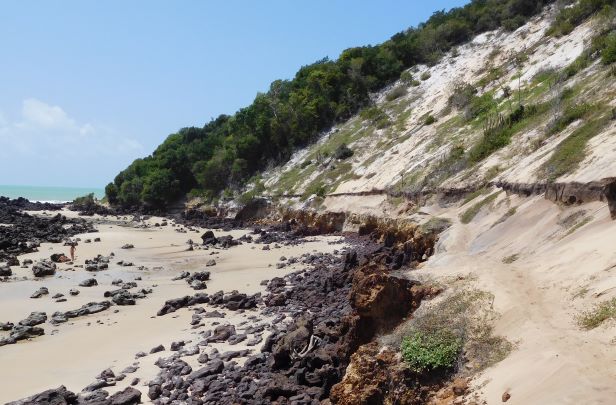
A raised beach deposit (dark horizon in the lower half of the cliff section) in the city of Natal, Brazil, hints to significant changes in the landscape caused by uplift. Image credit: Marthe Klöcking.
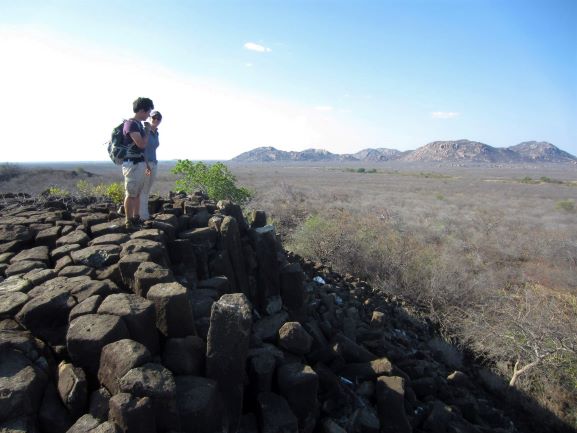
Marthe Klöcking and co-author André Guimarães in the Borborema province, Brazil, on the 8 million year old Cabelo de Negro volcanic edifice, showing columnar cooling structures. Image credit: Marthe Klöcking.
Scientists have speculated for some time as to the cause of dynamic topography, "based on positive gravity anomalies, mafic magmatic activity and stratigraphic evidence we know these features are dynamic – but it’s hard to define what exactly causes the uplift" says Klöcking.
"One of the simplest ways to raise the Earth’s surface is to put a mantle plume under the plate. In this scenario the lithosphere is pushed upwards by the hot and buoyant plume - but it would remain the same thickness" explains Klöcking.
But Klöcking’s findings show that the lithosphere beneath the Angolan dome has been thinned by as much as 30 km over the last 120 million years. The team were also unable to find evidence for a large increase in temperature, indicative of a mantle plume, beneath either region.
Klöcking and the team estimated present day mantle temperatures using seismic tomography, which images the subsurface of the Earth using seismic waves. By measuring the composition of volcanic rocks from the two regions, they were able to record the depth and temperature of melting below the surface. They also used xenocrysts - chunks of rocks brought up from the mantle - to reconstruct how Earth’s temperature profile varied with depth in the past.
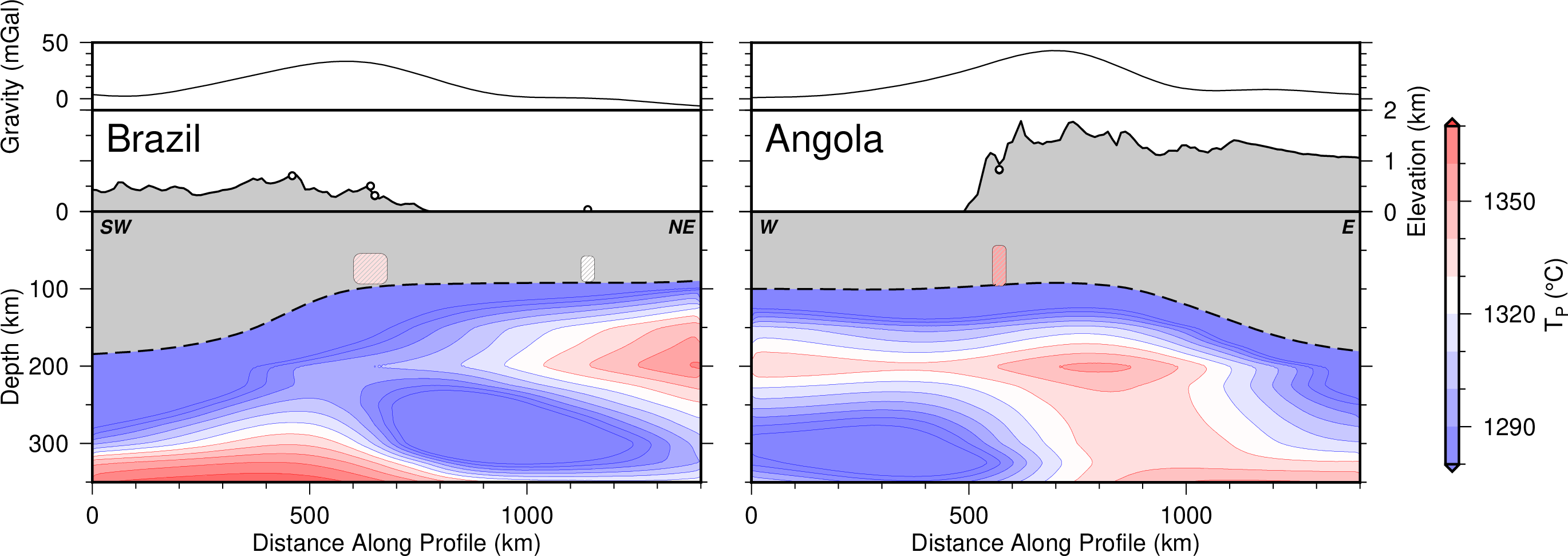
Sections through the uppermost mantle beneath (a) northeast Brazil and (b) southwest Africa. Lithosphere is shown in grey, while hot-cold colours indicate the temperature of the asthenosphere. The thin black line in the upper panel shows the satellite derived positive gravity anomaly above the topographic domes. Volcanic sample locations are shown as small white circles. Hashed polygons near the base of the lithosphere show the melting region inferred from volcanic geochemistry, coloured by temperature. Adapted after Klöcking et al. (2020).
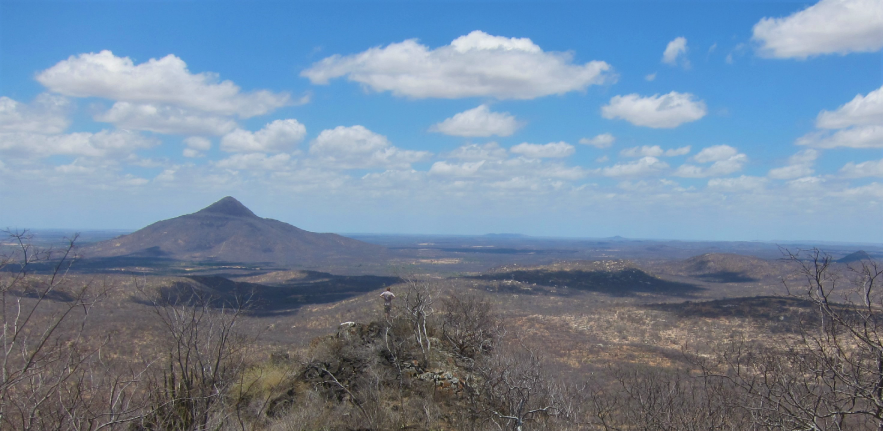
Looking towards Pico de Cabugi, the highest volcanic neck in the region, from the neighbouring volcanic peak of Cabugizinho (little Cabugi). Pico de Cabugi is roughly 25 million years old, and its broad shoulders are comprised of granitic country rock, whilst Cabugizinho formed 8 million years ago. Image credit: Marthe Klöcking.
"Neither the volcanic compositions nor seismic tomography support the existence of a large-scale thermal anomaly that you would expect with a deep mantle plume” explains Klöcking, “in both regions the volcanic chemistry indicates relatively shallow melting, originating from near the base of the lithosphere".
The team ran a series of model experiments to test if shallow warming in the asthenosphere could have caused the uplift, "a modest thermal anomaly would only cause a few tens to hundreds of metres of uplift – meaning that, in the absence of a buoyant plume, most of the high elevations must be due to the presence of a thin lithosphere" explains Klöcking.
So which came first, the thinning or the thermal anomaly? "We still aren’t sure whether the thinning itself funnels upwelling mantle towards the domes, causing advection of heat, or if it is the other way round and the thinning was initiated by a mantle upwelling that generated melting and eroded the base of the lithosphere", says Klöcking.
"We intend to continue investigating the exact process, but it seems likely that the thinning happened first in this case: either during breakup of the South Atlantic ocean in Cretaceous times or even earlier – some of the tectonic structures in both regions are thought to be very old".
The work highlights the benefits of collaborative research, "what made our work so novel is the many different techniques at our disposal, meaning we are finally able to understand what causes these enigmatic topographic features" comments Klöcking.
Klöcking, M., Hoggard, M.J., Rodríguez Tribaldos, V., Richards, F.D., Guimarães, A.R., Maclennan, J. and White, N.J., 2020. A tale of two domes: Neogene to recent volcanism and dynamic uplift of northeast Brazil and southwest Africa. Earth and Planetary Science Letters, 547.
